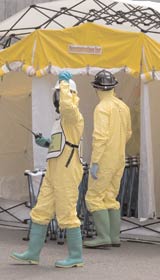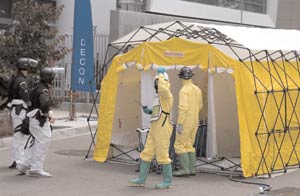
Spill Response: Utilizing Local Resources
There are a number of caveats to consider before creating plans that revolve solely around renting items as needed.
- By Karen D. Hamel
- Jul 01, 2007
 TANK overfills. Forklift punctures.
Floods. Earthquakes. Willful destruction.
Spill response planners are
tasked with creating plans for any possible
spill incident that could occur at a facility.
Often, however, the “best” or “ideal” plan
to handle a situation is scrapped because of
budgetary, manpower, or space constraints.
TANK overfills. Forklift punctures.
Floods. Earthquakes. Willful destruction.
Spill response planners are
tasked with creating plans for any possible
spill incident that could occur at a facility.
Often, however, the “best” or “ideal” plan
to handle a situation is scrapped because of
budgetary, manpower, or space constraints.
Sometimes, less-than-perfect plans are
developed because plan coordinators aren’t
aware of the wealth of resources available in
their communities. Acknowledging that the
facilities may not need to purchase or store
all of the items they could ever possibly
need is an important first step toward
achieving a more ideal spill response plan.
Consider an ‘Ideal’ Plan
After determining all of the scenarios that
could face the facility, imagine for a
moment that budgets are no object, and
that a plan can contain any and all equipment
or personnel that would ever realistically
be needed.
Instead of saying, “Gosh, it would be
nice it we could . . .” or “Man, it would be
great if we had . . . ,” pencil it into the plan
if it is a reasonable and realistic resource.
Filling a plan with items that don’t currently
exist or would be frivolous or
overkill sets unrealistic expectations and
diverts the efforts of obtaining items that
will be truly beneficial.
Realistic resources might include
things such as backhoes, generators, pump
trucks, portable tanks or containment,
flammables vacuums, decontamination
tents, incident command equipment, large
stores of absorbents, personal protective
equipment, air monitoring tools, remediation
equipment, and
calling in additional
responders.
Include anyone
who will be responding
to, or has
responded to spills in
the facility during
this discussion. Many of them have experience
responding to previous spills and can
add valuable insight as to what they would
like to have on hand or would be comfortable
using in the future.
Make a Wish List
Review the new “desired” plans, listing all
of the resources. As each resource is listed,
determine whether it is already on site (for
example, spill kits), whether it is something
that can be purchased, stored, and maintained
on site (for example, a specialized
vacuum or decon tent), or is something
that is not practical to store, there is not
currently space to store or no budget to
obtain (for example, backhoes or aid from
outside resources).
For facilities that have had plans in place
for a while and have been diligent in maintaining
their response equipment and supplies,
many items may already fit the first
category, with only a few items on the actual
“wish list” of resources that can’t be stored
on site or are too expensive to obtain.
Creating a list of resources has the
added benefit of also serving as a checklist
for future inspections, plan reviews, or
restocking after an incident.
Obtain Resources
Resources can be obtained from a number
of different entities. One place to get started
is the local Emergency Management
Agency (EMA) Office or Local Emergency
Planning Committee (LEPC). These entities
are often based in a single county,
although they can be city-run for larger
cities or multiple-county in rural areas.
No matter what the governing authority
is, though, its personnel should be able to
refer you to companies or organizations in
the local community that can help with
response resources.
Local Hazmat Teams
Hazmat response teams are often found at
the county level. In small to mid-sized communities,
it is not uncommon for firefighters
and other first responders to be
cross-trained to handle hazmat incidents
that are likely to occur in their county.
Because of the nature and scale of responses
they are prepared to handle, they often have
“big ticket items” such as pump trucks, mass
decon supplies, air monitoring equipment,
incident command equipment, and large
quantities of absorbents and PPE.
Although it is impractical to call them for
every little spill, they can be a great resource
for catastrophic spills, especially when the
spill is facility-specific and not related to a
community-wide natural disaster such as a
flood or earthquake. Many county teams areeager to be involved in facility response
plans. Incorporating them into those plans
and allowing them to drill with on-site
responders has a mutual benefit.
The outside teams become familiar with
the facility, which benefits them if there is
ever an actual emergency for which their
assistance would be called. It also helps
them become more comfortable in other
facilities with similar processes. On-site
responders benefit from the knowledge of
the outside teams. Outside teams are often
more aware of new technologies and maintenance
techniques for existing supplies.
They may also play a role in allowing for
more responders per entry team, to speed
response efforts.
Utilizing outside response teams for
larger incidents and drills also allows both
on-site and outside responders to practice
incident command structure. Although
this is not of the utmost importance in
small incidents, it becomes absolutely vital
in a large-scale spill response. As all
responders become more familiar with one
another and their roles in the response,
they are better able to function within the
structure, allowing the overall operation to
run more smoothly.
If an agreement is made to use outside
responders as part of the plan, it is important
to keep contact information up-to-date
and equally important to continue
including the outside responders in drills or
changes made to response plans. This
enables the outside responders to provide
the best aid possible in an actual spill
response situation.
Non-profit Organizations
If spill response scenarios involve evacuating
or treating large numbers of victims, utilizing
community outreach organizations
such as the Red Cross or Salvation Army
may be extremely beneficial. In addition to
providing training seminars, these organizations
are skilled in handling, treating, and
otherwise caring for the needs of large numbers
of people. They are well versed in
calling in the additional resources they need
to support their operations and know how to
work within an incident command structure.
As with outside response teams, it is not
practical to call them for small incidents,
and they may not be available to specifically
help a single facility in a community-wide
disaster. If the facility is able to include
them as a resource for large facility-specific
incidents, however, it can ease the burden
on the facility to train an on-site team to
handle these issues and to stock all of the
potentially necessary supplies that would be
needed to support numerous victims with
varying needs.
Local Companies
Earth-moving equipment, generators,
tents, and other supplies usually are “readily
available” in most communities, and
renting an item “as needed” can be a great
option compared to buying an item that is
likely to sit around and never be used.
There are a number of caveats to consider,
however, before creating plans that revolve
solely around renting items as needed.
The first is the location of the rental
facility. If you need a backhoe to create an
earthen dam to contain 10,000 gallons of
fuel or a tent to set up an incident command
post and the closest rental company is 30
miles away, chances are good these supplies
won’t make it in time. Heavy traffic could
create additional delays.
Trailers or trucks with hitches also may
be necessary to transport the equipmentfrom the rental company to the facility. If no
one has towing or hauling capabilities, plans
to rent equipment may become irrelevant.
Even if the rental company is conveniently
located, if there is a natural disaster,
the equipment that is needed may not be
available because it is being used by others.
With these things considered, when
resources are to be rented as needed, it
becomes very important to document the
availability of these resources in plans. Discuss
availability with the rental company
and make sure everyone is comfortable with
the probability of the resources being available
when they are needed.
It is also a very good idea to list backup
resources for all items to be rented so that
they are readily available if the primary contact
does not have the necessary items in
stock when they are needed.
Neighboring facilities may be able to
provide additional response resources, as
well. For facilities located in industrial
parks, large response items may be shared.
Working with neighboring facilities is a
great way to share the cost of items that
many facilities could utilize when needed.
Be certain, however, to document the
storage and maintenance agreements ahead
of time so that all facilities are aware of their
commitments.
Pulling it Together
Using outside resources does not relieve a
facility of its obligation to have spill
response plans in place. Plan coordinators
also need to consider whether or not these
options are indeed viable and practical for
their facility. Response drills are one way to
help determine this.
When outside resources are going to be
used as part of the plan, make sure everyone
involved knows about it. If outside responders
or support will be used, make time to
drill with these entities so everyone
becomes familiar and comfortable with one
another. Make sure on-site responders
know whom to call and when to call them.
If outside equipment will be utilized,
bring it in during drills and train responders
to use it. For instance, it doesn’t make sense
to know that you are welcome to borrow air
monitoring equipment from the hazmat
team if no one on site knows how to use it.
On-site responders need to be comfortable
using borrowed items so that during an
actual response, time is not lost wondering
how something works.
It is also very important to keep plans
and contact information up to date. Verify
contact information for rental companies at
least annually. If outside responders or
organizations are included, make sure they
have copies of the up-to-date plans for their
records and training.
Although using outside resources can
make plans a bit more complicated, the
benefits of having created plans that will be
easier to enact and using resources that will
meet every need far outweigh the inconvenience
in planning. Responders will be
better able to fulfill their roles. Outside
agencies, when needed, will be ready and
able to assist.
This article originally appeared in the July 2007 issue of Occupational Health & Safety.